 |
|
|
|
|
|
|
|
|
|
|
|
|
|
|
|
|
|
|
|
|
|
|
|
|
|
|
|
|
|
|
|
|
|
|
|
|
|
|
|
|

Lighting of sculpture and objects
The lighting of sculpture and 3D collectibles in residential settings can be challenging. Relatively low ceilings can make surface mounted fixtures overly obvious, while recessed fixtures take substantial planning to insure correct placement.
On the other hand, the lower ceiling means a shorter object to light source distance and allows lower power bulbs and more compact fixtures to be used. None of the fixtures mentioned here have any focusing optics associated with them. In all cases, changes in light intensity is achieved by varying the wattage of the bulb. Changes in beam angle or directionality, are a function of the bulb itself, be it spot or flood.
There are many bulbs available in many styles, but only a few styles are readily suited to residential situations. Characteristics of interest are , a well focused beam, good color rendering, compact size and ready availability.
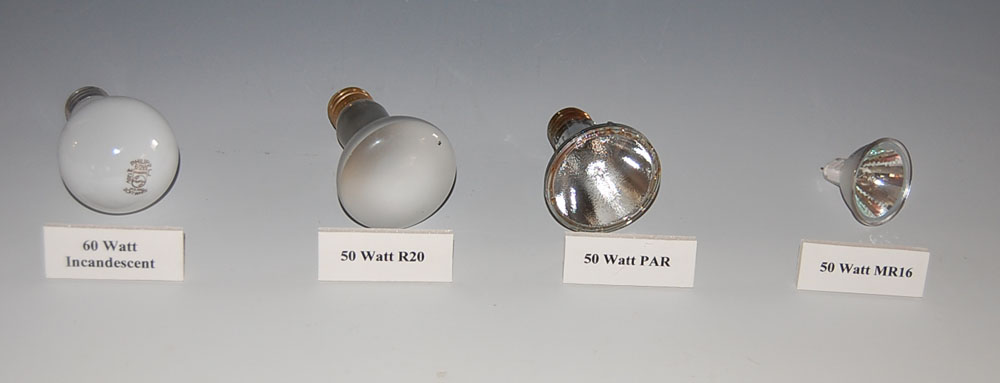
The image above shows four commonly available bulbs and their relative sizes.
1) The 60watt, medium base bulb has no directionality to its beam and has a yellowish cast to its light. These bulbs are of little use for display because of these features
2) The 50watt R20, medium base bulb, (R stands for reflector), has some directionality to is beam. Available in spot and flood versions. The spot is not very tight, perhaps 15degrees, and there is a fair amount of light spill through the back of the bulb. This bulb also has a yellowish cast to its light. Best suited to a closed back track fixture or recessed lighting. They are not as useful for display as the bulbs that follow.
3) The 50watt PAR20, medium base bulb, (PAR stands for parabolic reflector), has good directionality due to the much more reflective inner surface and shape of the enclosure. Generally these are halogen bulbs and cast a very pure white light without much color bias. Available in spot and flood versions, the spot is about 12 degrees. This is the most useful of the bulbs discussed thus far. They fit common track and recessed fixtures like those below.
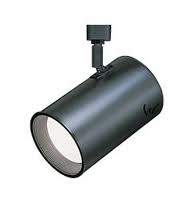
.jpg)
All of the bulbs discussed above are line voltage, (115-130V), meaning that they will work in any common fixture that they fit in. The fixtures them selves will have a rating of what the maximum wattage is, this rating should always respected for fire hazard reasons.
4) The 50watt MR16 bulb, ( MR stands for multifaceted reflector) is a 12 volt bulb with a bi-pin base. This bulb will only fit fixtures with a bi-pin receiver. These are halogen bulbs with a pure white color, good color rendering and excellent directionality. They are available in various spot and flood configurations from 9 to 35 degrees beam spread. Additionally this bulb is only 2” (50mm) in diameter as opposed to 2.5” (63mm) diameter for the PAR20.
Being a 12volt bulb requires that the fixture be able 12 volts . Recessed ceiling fixtures will typically have their own transformer allowing them to convert line voltage(115-130volts) to 12volts at the fixture. Placement of the recessed fixture can be constrained buy structure within the ceiling but if the correct placement can be achieved, this is the most professional looking and discrete installation.
There are standard track fixtures that have their own transformers and can be used on regular line voltage track with out any changes
.
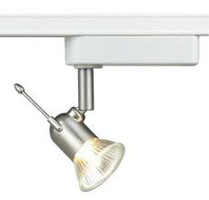
.jpg)
There are also track systems that use a transformer at the feed end , so that the entire track is 12volt. In some cases the transformer is hidden, but more typically it is surface mounted and has a decorative housing. This is typical of the cable track and flexible track systems shown below.
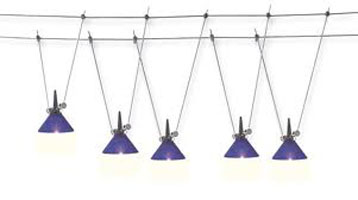

Surface mounted track systems allow great flexibility of fixture placement at the cost of a more visible installation. The small MR16 bulbs allow the fixtures to be as discrete as possible plus some of the cable track fixtures are quite interesting design wise.
Generally speaking the overhead lighting should be placed slightly to the foreground of the sculpture to allow light to wash the piece and create highlights and shadows. Many times one light is adequate for this task, but there are times when two lights placed 1.5’ (50cm) apart provide superior coverage. Below are examples of single and double lighting. This needs to be considered in context of the specific installation
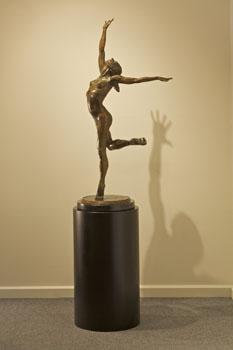
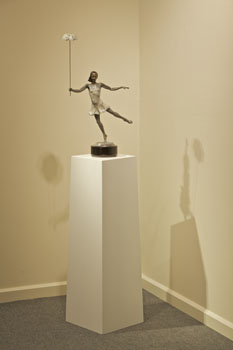
The core of this commentary is that MR16 bulbs are compact, have good color rendering and are versatile , having power levels of 20 to 75 watts and beam spreads of 8 to 40 degrees. There is a vast array of both recessed and surface mount fixtures available to use with them. They are a readily available consumer product with a variety of price points.
There is a steady shift towards energy saving LED, (light emitting diode) lighting across many applications.
Currently, (March 2011) there is little available in LED that can compete with MR16 halogens for display purposes. LED is not yet at the peak lumen output of the halogens.. There are a variety of MR16 format LED replacement bulbs available but they do not yet have the total lumen output of the MR16 halogens that they try to replace. In most cases they lack the power to make a sculpture strikingly lit in a display.
One manufacturer, Hera Lighting L.P , is making some LED fixtures that are very interesting for small objects and short object to light distances. Here are some links.
A micro recessed can. http://www.heralighting.com/hera/eye_led.html.
A small, stem mounted spot. http://www.heralighting.com/hera/flex_led.html
LEDs have very interesting possibilities for under lighting of translucent objects. Please use this link to go to that commentary.